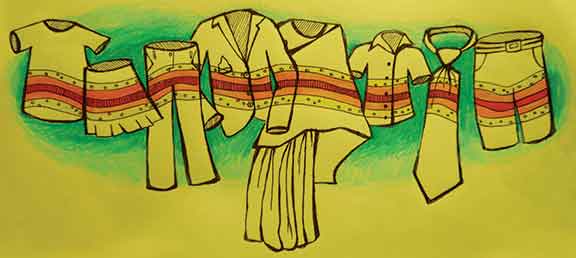Damayanti Mukherjee
In contemporary parlance, use of gender neutrality is quite in practice – in fact the personal pronouns of ‘he/she’ are scrupulously avoided even in official documents. However the school diaries/handbooks of most co-educational institutions have specific instructions as far as dressing of students go. In fact, school uniforms are one of the institutionalized forms of gender differentiation in times when all efforts are being made to eradicate instances of differentiation.
The natural and physiological difference between genders is often cited as the common sense point for designing and prescribing different models for boys and girls/young adults – male and female. Added to this is the factor of cultural sensitivity and community or religious prescriptions. The point to ponder upon is: the dress code of an organization speaks about its ethos and therefore one needs to study the factors that influence that ethos.

It is not only in schools that uniforms are prescribed but all services and many corporates also mandate this. Therefore let us all agree upon this point that the basic logic of having a uniform is to establish a sense of unique identity. Now the question is: is this identity organizational or should this be split into organizational male and organizational female? Is stereotyping ad hoc or is it due to certain considerations?
Being an educator exposed to both national and international curriculum and sensitized to a wide variation of school environments, I would say there is no single answer nor is there much scope for judgment.
In pre-independence India, wearing traditional Indian attire to school was a norm for both boys and girls. As western education, especially that facilitated by the Christian missionaries spread, there was also a change in the form of school uniform with boys adopting short and long trousers but in many cases girls continued to wear leg-covering sarees or salwar-kameez. This also underwent changes over a period of the next 30 years but was more palpable in urban India rather than in the suburbs.
When talking of school uniform in the present times, one must distinguish between formal and sports uniform. While formal uniform still remains gender distinctive, many schools promote wearing of same design of PE uniform by boys and girls in a co-educational context. The main factors that influence this decision are comfort, material choice and expressly seeking a homogenous option for sports that is beyond gender rules.
I took a student poll on this question and results were rather different from my presumption. Among the 100 odd students I contacted (50 boys and 50 girls), 93% of the boys could not care less and seemed much more bothered about regulation haircut or the necessity of wearing ties or the bigger question of wearing uniform at all. The response from girls, both national and international curricula, was mixed. While most girls did not like the idea of Indian attire as choice of uniform, most preferred a gender specific skirt-blouse-blazer combination to wearing trousers. Some had an interesting proposal about boys adopting the Scottish kilt to match the school skirt. Most senior girls felt the feminine figure is best expressed in gender specific uniform and though they prefer being in jeans and T-shirt in the personal sphere, adopting formal trousers in lieu of skirts was not an attractive option.
Uniformity in school uniform thus remains an open question.
The author is an English teacher by passion and vice-principal of Indus International School, Hyderabad by profession. She likes to read, write, cook and travel. She can be reached at damayanti.indus@gmail.com.
